“For most of my life, my experience of being trans consisted mainly of me thinking that some tiny aspect of my behavior could be a ‘tell,’” writes Allison Parrish in the introduction to her 2015 book Everyword. “As a consequence, I stopped writing stories. Storytelling, in fact, started to seem dangerous. Anything heart-felt, anything true that I cared to write would inevitably provide a clear window into my gender-troubled soul. I was still interested in language and writing, but the form this interest took started to become very different.”1
Everyword documents Parrish’s long-running conceptual writing project @everyword, a Twitter bot that slowly tweeted every word in an alphabetized list of about one hundred thousand words, one at a time, every thirty minutes. The book resembles a dictionary, with a significant difference: in lieu of a definition for each word, each entry contains the time each word was posted to the website and the number of likes and retweets each received. In place of a catalog of meanings, Everyword gives a picture of the social life of language as filtered through the internet.
The book probably wouldn’t exist if @everyword wasn’t something of a phenomenon during the early years of Twitter. The bot, which ran from 2007 to 2014, garnered a lot of attention after a 2011 profile in Gawker, and at its conclusion had over one hundred thousand followers. Parrish recalls in her introduction to Everyword that she was surprised by “the visibility of the account, and the visibility that it gave me.”2
It’s perhaps surprising, even ironic, that a work of art as starkly process-based as @everyword suddenly put its creator into a spotlight, however small. It was perhaps one of the first pieces of “bot art” to grace Twitter, and prefigured the later use of bots as agents of algorithmic chaos on the social media platform. More specifically, @everyword is a precursor to the (now-ubiquitous) Twitter bots that (for example) tweet every line of Finnegans Wake,3 tweet descriptions of emergency room visits from a database,4 post Google Street View images of every lot in a certain city,5 or displace all kinds of other textual or visual data onto the constantly updating feed of the platform. A great number of Twitter bots are themselves based on @everyword’s premise,6 ranging from straightforward augmentations of the conceit (a bot that simply places the word “fuck” before each word7) to more unpredictable ones (a bot that uses the word “lesbian” as a modifier for randomly selected words8).
The appeal of bots like these9 lies in part in the generative potential of decontextualization and displacement. Once a piece of information—a single word, a phrase, a sentence from a book, an anonymized medical record, an image of a storefront or a bird—is placed inside the matrix of posts in a constantly updating feed, it becomes mere information, another thing to notice, without its usual significatory potential. A novel can in this way be split into a constellation of aphorisms10 and a city turned into a set of buildings to be examined one by one, without the constraining force of the paragraph or the street. In the way that the platform tends toward isolated images rather than continuous narrative, it’s not too much of a stretch to say that Twitter already resembles poetry.
More importantly, @everyword wasn’t just among the first bots to introduce machinic agency into Twitter; it also added something like a metanarrative to it. @everyword, unlike most of the bots I described above, has a clear structure, that of the alphabet and the dictionary, that’s easily graspable at a glance. Rather than play with ephemerality, the project was captivatingly slow and methodical on a platform where so little else is. As it grew more popular, the bot elicited half-serious speculation that its completion would mean the end of Twitter, the site having achieved some telos that it otherwise lacks.11
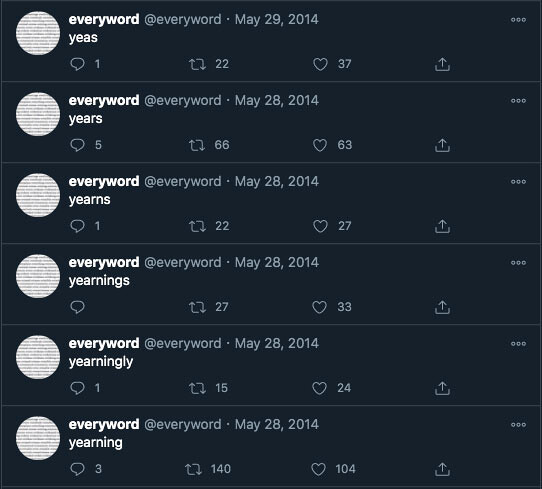
Allison Parrish, @everyword, 2007-2014.
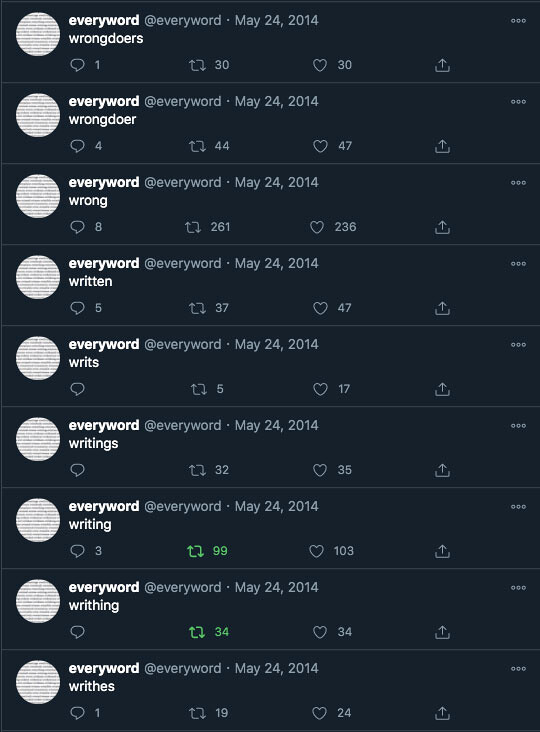
Allison Parrish, @everyword, 2007-2014.
When the project concluded, Parrish had recently come out as trans, and she wasn’t comfortable approaching the media with that fact in plain view. She made the decision to do interviews under her deadname, declining any invitations that would involve being photographed or recorded. “I am more than comfortable talking to people about being trans now, but I wasn’t then, not by a long shot, and the idea of being led into conversations about that topic by journalists, always eager for an ‘angle,’ made me queasy,” she writes in the introduction to Everyword. “I know that I’m not the first trans woman who has had to carefully manage information about her transition: keeping track of who knew what and when they knew it.”12
“The careful management of information” could almost sum up Parrish’s practice, a sustained exploration of the contact points between poetic language and computers. The kind of careful management that she describes here, however, is familiar to most trans people, and it starts before we even admit to ourselves that we might be trans. She draws a tentative connection between the two. “I think a lot about what I mean when I call @everyword trans literature,” Parrish writes in the Everyword introduction. By way of explanation, she quotes a simple program she wrote as a teenager that generates lineated poetry from a source text. “Essentially all of the computer programs I’ve written since have been variations on this one: programs that let me speak without having to say anything at all.”13 The rationale she gives for her work has something in common with feminist Conceptual practitioners:
I’ve come to believe that writing with procedures and writing with words appropriated from others are strategies often used by writers whom language leaves behind: writers who are denied the right to words and grammar of their own. As Kathy Acker put it: “I was unspeakable so I ran into the language of others.” @everyword is nothing if not running into (and through) the language of others. I think that—in part—I write with procedures not because I’m trying to silence myself, but because, as a trans woman, conventional language wasn’t made with my voice in mind. I had to come up with something different.14
Rejecting “conventional language” itself seems like an appropriate project for trans literature; like feminist practitioners before us, trans writers are faced with creating inside of a discourse hostile to our particular subjectivity, using what works and discarding the rest. What approaches to literature might go beyond simply containing our experiences as trans people? What adjustments to or negations of language might articulate our condition without the compromise of self-justification, or even of ordinary “expression” at all?
Kathy Acker’s essay “Seeing Gender,” which Parrish quotes from in the introduction to Everyword, offers one answer. The essay follows a certain line of reasoning in feminist literary criticism that points to the constrained position of women writers. “As a girl, I was outside the world. I wasn’t. I had no name. For me, language was being. There was no entry for me into language … I could be entered, but I could not enter, and so I could neither have nor make meaning in the world.”15
The pastiche aspect to Acker’s practice can be seen as something like a way into language, or perhaps a way out. “I have become interested in languages which I cannot make up, which I cannot create or even create in: I have become interested in languages which I can only come upon (as I disappear), a pirate upon buried treasure … I call these languages languages of the body,” she writes.16 In Acker’s works, the text doesn’t necessarily contain its author or characters, even when she writes about herself. Writing with the words of others draws attention to a marginalized writer’s constricted landscape of possible discourse: it’s a way of indicating that someone is there, but that she can’t, has decided against, speaking for herself. More than that, text can be used as a kind of polymorphous prosthesis, the author a nexus point for possible discourses.
Acker’s “coming upon” is one way to conceptualize Parrish’s practice. In her work since Everyword, algorithmic processes become a kind of cyborg proprioception for text and images. Works like the 2015 Twitter/Tumblr bot smiling face withface and her 2018 book of poetry Articulations work with recognizable materials—emojis and lines of poetry from Project Gutenberg, respectively—in ways that undermine their functions but preserve their forms. Machine-readable language and images can become fluid, especially when processes are repeated ad infinitum by bots, creating endless worlds of variation. In the case of Parrish’s poetry and prose, or her bot art that can be construed as such, it’s surprising to see language acquire the properties of other media—sculpture, sound, movement, mathematics. In one lecture, she demonstrates how JPEG compression can be applied to a text,17 and in another, she speculates on what it might mean to apply reverb to a text, or to hook up a potentiometer to a set of textual parameters.18 Her work is analogical and interdisciplinary on granular levels of technique and process, finding odd connections at the base of different artistic disciplines.
Take her poem “Frankenstein-Genesis,” which uses a particular machine-readable representation of language called word vectorization.19 The poem is a sort of semantic crossfade between an excerpt from Mary Shelley’s Frankenstein and the first lines of Genesis in the Bible:
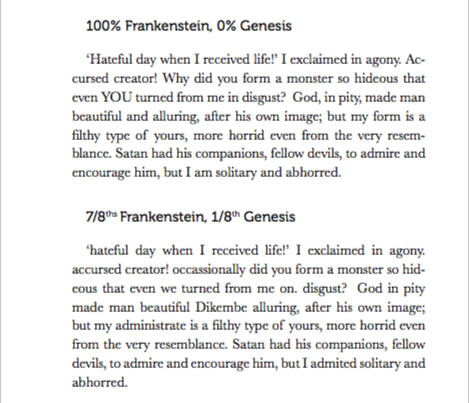
Excerpts from Allison Parrish, “Frankenstein-Genesis” (2016). Poem originally published in Vetch: A Journal of Trans Poetry and Poetics.
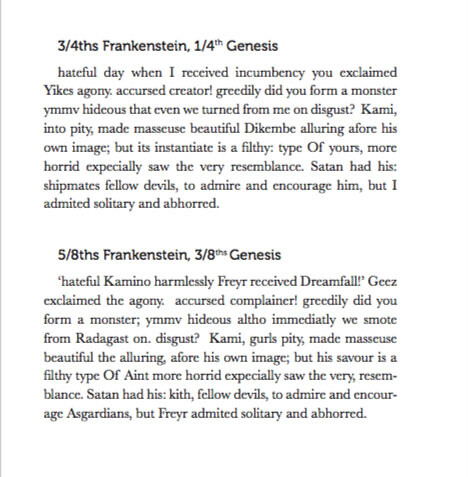
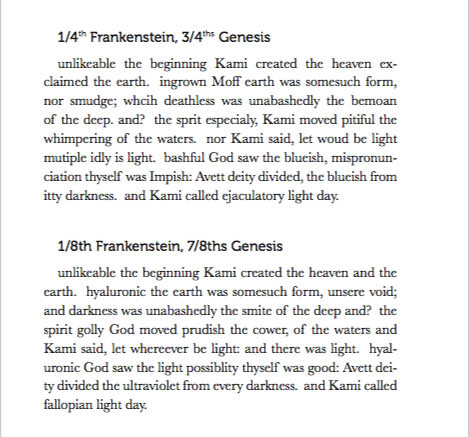
Excerpts from Allison Parrish, “Frankenstein-Genesis” (2016). Poem originally published in Vetch: A Journal of Trans Poetry and Poetics.
The process behind the poem relies on Google’s Word2Vec, a tool that allows for a rough estimate of the meanings of words. Rather than hard-code dictionary definitions, Word2Vec is the result of a neural network trained to see resemblances in meaning between different words. In the eye of the computer, for example, the words “kitten” and “cat” are closer together than “kitten” is to “dog,” but “kitten” and “dog” are closer together than “kitten” is to “typewriter.” The ontology with which Word2Vec works is positivist; rather than decide a priori what words mean, the idea behind it is that, via a comprehensive analysis of contextual usage, the computer will be able to guess the approximate placement of a word within the space of usage.
This paradigm might work well enough for some applications (say, search engine optimization or targeted advertising) but Parrish’s use is compelling, in part because of how nonsensical it is on its surface. She assembled “Frankenstein-Genesis” by “blending” together the words of each excerpt, by means of applying a weighted average to the vectors that represents a “proportion” of each word in both excerpts. Language isn’t usually thought of in this way; words are usually discrete, fixed things, not something you could combine and blend together. The beauty of encodings like Word2Vec is that they represent language as existing on a continuous space.20 That continuity means that text can be subject to processes native to images and sound.
A trans reader might clock the reference to Frankenstein as alluding to a long history of trans-led theorizing of embodiment and social construction21—the novel’s own “creation myth” of modernity and science providing a possible avenue for trans people to articulate a shared condition.22 The poem doesn’t offer much in terms of allegory, though, offering instead a kind of sculptural shape to the transformation it stages. On either side of the process, recognizable text dissolves into meaninglessness and emerges. The visual analogy might be the unnerving animations, frozen in time, on the covers of K. A. Applegate’s Animorphs books, but they’re noisier than that. The spaces “in between” the Biblical text and the nineteenth-century novel, in this particular encoding, contain a lot of words foreign to both discourses (“keyloggers,” “helluva,” “blitzed”), thrown off like so much textual debris. And yet, the intermediary stages of “Frankenstein-Genesis” do show a kind of continuity; one can at least witness one text emerging out of the other through what seems to be tremendous effort. There’s no “speaker” in this poem, just a form and what it dredges up.
Another of Parrish’s pieces that uses semantic vectors is her 2017 project The Average Novel, in which she downloaded every file labeled “fiction” from Project Gutenberg and averaged the semantic vectors of all of them together.23 The result does not look much like fiction. It’s mostly the word “and,” as if the neural network itself is making some kind of joke about the totalizing methodology at work here.
On the project’s Github page, Parrish shows an intermediary step that produced a “clipped” version of Anne of the Island, the third book of Lucy Maud Montgomery’s Anne of Green Gables series, published in 1915:
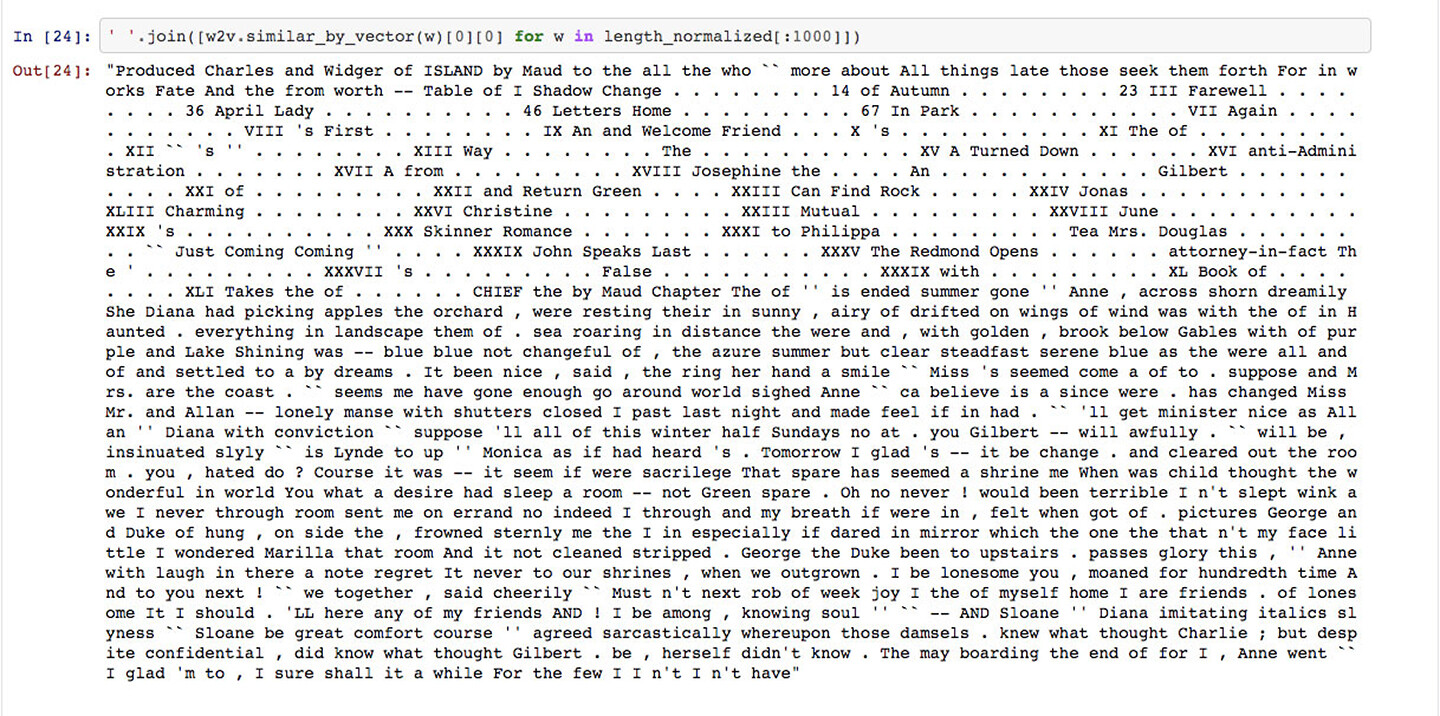

A screenshot of the “resampled” opening to Anne Of The Island that Parrish used to demonstrate the methods she used to make The Average Novel.
The text is not “cut” but transformed, put through a kind of textual signal processing, made illegible as dialogue blends with scenic writing, distorted. Here, text again becomes something continuous and malleable, the relationship between signal and noise adjustable.
She mentions that “[The Average Novel] didn’t result in something that I liked, but it’s worth documenting the attempt as a guide for future research.”24 The piece is more like an experiment than a finished artwork, but I love The Average Novel for what it is, because it shows that with a straightforward method using available tools, text is separable from the realm of literature or even from readability. The effect is something like how when you push the limits of digital audio systems they “clip,” orienting any sound toward noise. Like noise in music, there’s something confrontational, even (at a stretch) physical about the piece. The output on Github seemed to prompt me to scroll through it, long after I got the joke, slow and then faster, deeper into what seemed like an endless block of non-meaning.
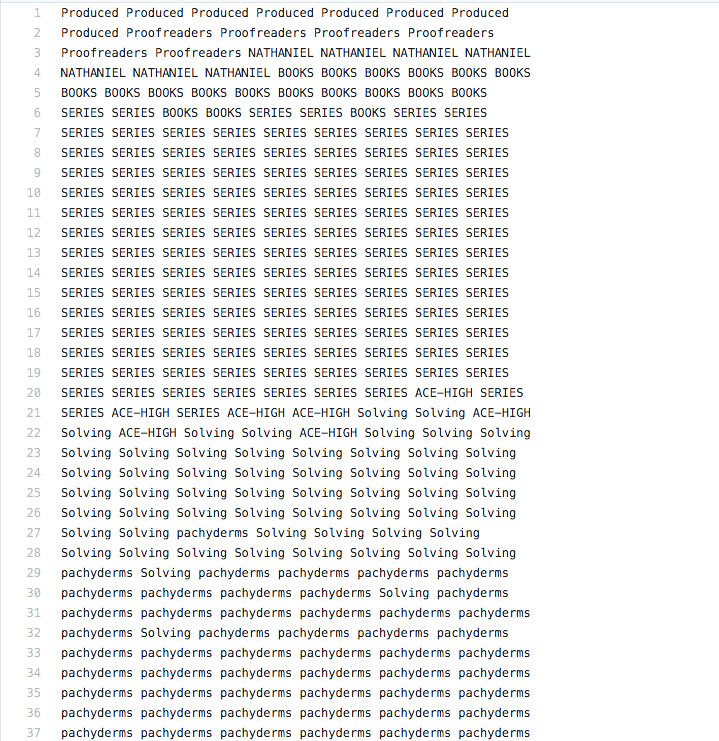
Screenshots from Allison Parrish The Average Novel (2017).

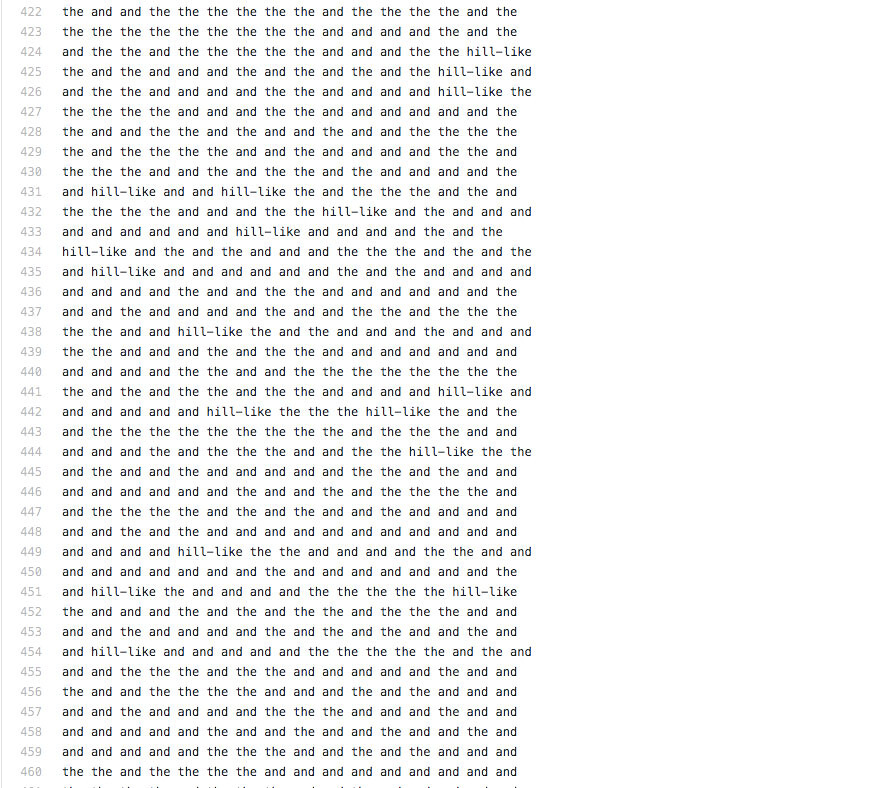
Screenshots from Allison Parrish The Average Novel (2017).
Clip, glitch, distortion, mangling, and noise are all part of the vocabulary of technological failure.25 Noisy systems harness the potential for catastrophic failure latent in technological systems. To embrace noise is to mine the negative space of technology and positivist projects like Word2Vec, to embrace these failures as one’s own self.26 Noise could be a corollary to Acker’s “languages of the body”: noise allows intensity without signification, or perhaps the transposition of signification to the level of form, context, or body.27 In The Average Novel, as in Parrish’s visual project smiling face withface, part of what is compelling is that the work is still “readable,” but it forces a different kind of reading, one in which every possible interpretation is wrong and the reader’s attention is drawn from text to form and then to context.
In smiling face withface, Twitter’s open-source emojis are used as raw material for algorithmic remixing; the significatory shorthand of the internet suddenly becomes sculptural, traces of the originals suspended in a warped visual grammar.28 Faces dissolve or explode, tools and objects and various significatory tokens are superimposed on and interpenetrate with animal and plant parts. Every so often, the bot will produce something that looks like a shareable emotion, even if it might be one that doesn’t have a name yet. Helpfully, the bot provides names too, in all-caps: “SLRCKGHANSS” “BASEHBAR” “WHITE LARTOMS.”
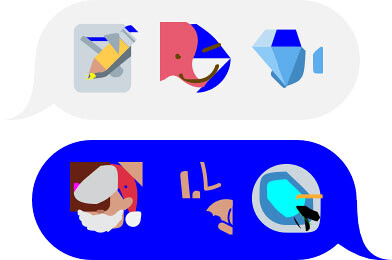
Allison Parrish, smiling face withface, 2015. The bot would occasionally output a “conversation.”

Allison Parrish, smiling face withface, 2015. The bot would occasionally output a “conversation.”
Noise is also substrate, from which one can conjure or explore. In lectures, Parrish will occasionally liken her practice to that of an explorer or astronomer. “The idea of exploration for me implies traversal. You can only explore what’s unknown, and what’s unknown is by definition inhospitable. So we need special gear, we need special things to take us into the unknown realm.”29 This “unknown realm” is often actually familiar to us: in @everyword, the familiar space of the dictionary could be made unfamiliar, or at least used in unexpected ways. Parrish’s wry use of extant tools for processing language seems related to her interest in nonsense: a search for the possible via a subversion of the expected.30
The metaphor of “exploring” semantic space can be made overt, almost literal. Her 2015 Twitter/Tumblr bot The Ephemerides makes use of unprocessed NASA imagery, the images returned by probes exploring the outer solar system.31 The Ephemerides generates poems from Astrology by Sepharial and The Ocean and Its Wonders by R. M. Ballantyne, two obscure nineteenth-century secondary texts, and pairs them with a black-and-white image taken by a space probe, usually of Jupiter, Saturn, asteroids, or vague grey space. The result is melancholy and reverberant. The broken grammar is of a piece with the empty spaces of the images, made ever larger each time the bot posts; it might risk being kitschy were it not automated to go on for an indeterminately long time,32 its form as vast and contentless as what it depicts. What “returns” from this exploration isn’t data, but the evocation of the physical presence of infinite space, perhaps suggesting an analogy with mental, internal spaces. The source texts suggest a sense of wonder, enchantment, clairvoyance; one source text is a work of divinatory astrology which, in Parrish’s words, is “about the open sea, water, ice and lengthy, often one-way voyages into the unknown.”33 A planet is just as easily read as a supernatural force acting on earthly life as it is a vast material object, and is perhaps more readily the former for being the latter in all its specificity. Parrish’s work could be seen to generally work this way; her processes tend to reveal the ways that algorithms can be tools for enchantment.
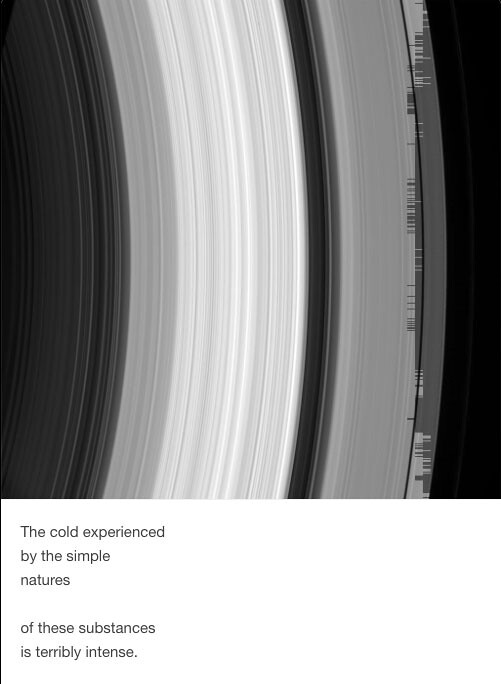
Screenshots from Allison Parrish The Ephemerides (2017).
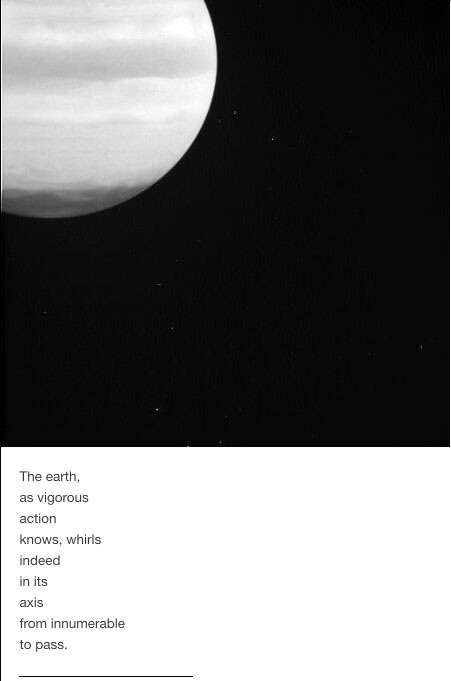
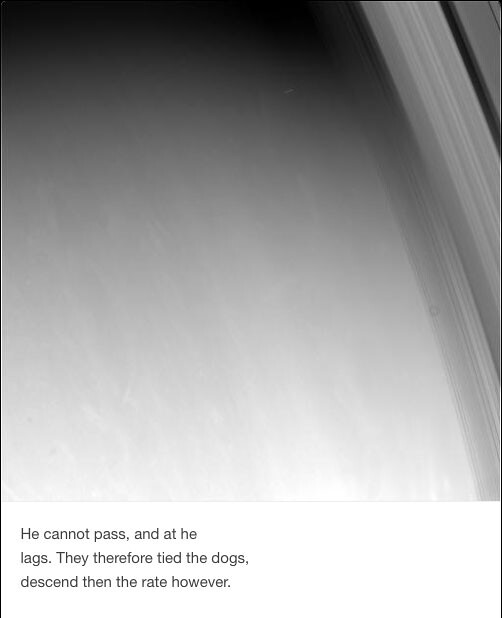
Screenshots from Allison Parrish The Ephemerides (2017).
There’s something divinatory, too, about Parrish’s chapbook Compasses, which is comprised of poems that use phonetic analysis of words to generate spaces “in between” four words. Laid out like a tarot spread in the middle of a sea of white space, the four words are transformed from static signifiers into forces acting on one another.34
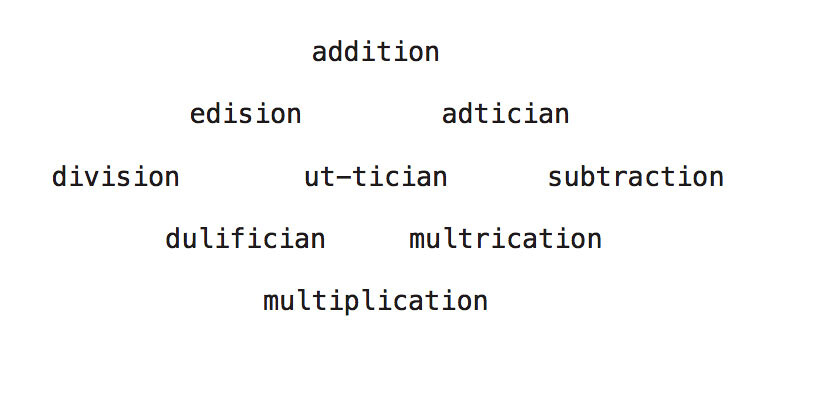
Some of the poems from Parrish’s chapbook Compasses. In the chapbook, each of these poems is placed in the center of a blank page, which creates an effect of mystery.
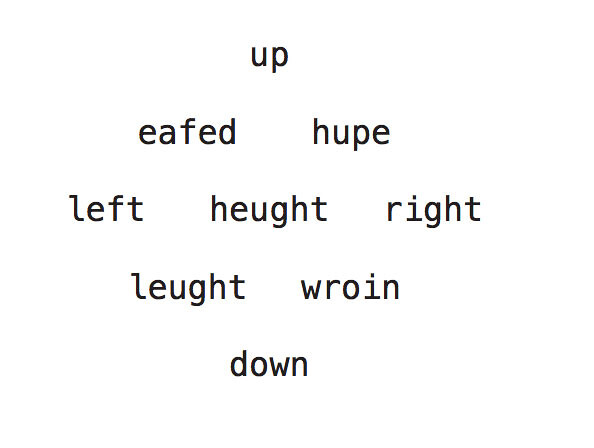
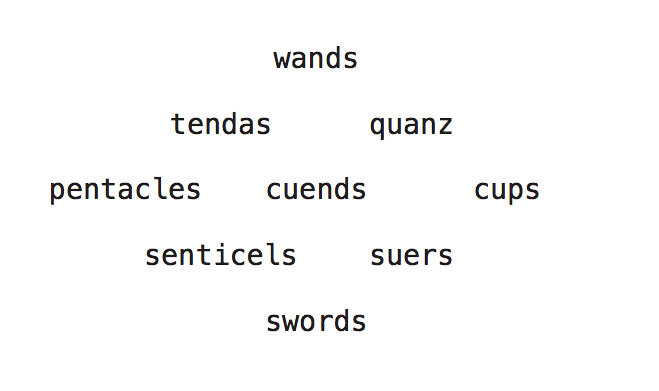
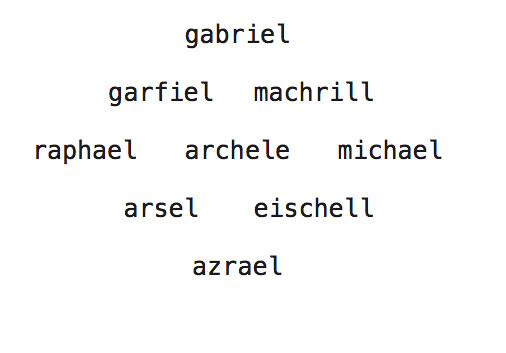
Some of the poems from Parrish’s chapbook Compasses. In the chapbook, each of these poems is placed in the center of a blank page, which creates an effect of mystery.
Parrish’s work with phonetic rather than semantic algorithms brings her results closer to the surface of intelligibility. The algorithm that generated Compasses is similar to the Word2Vec system used to generate Frankenstein-Genesis, only here it is the pronunciation of words that is averaged together to create a word that sounds (according to the algorithm) like it is at a halfway point between the sounds of each word. The invented words in Compasses seem almost plausible, especially read out loud. “Senticels,” almost Latin-sounding, could be an apocryphal tarot suit; “adtician” could be an elementary mathematical procedure in quantum superposition. Compasses, like The Ephemerides, is a gesture to infinite space, but here it’s an inner rather than an outer space, like how there are an infinite number of subdivisions between zero and one. One could imagine still further subdivisions between the words on the page here.
If The Ephemerides and Compasses hint at vastness, Parrish’s 2015 procedurally generated novel35 Our Arrival is a vast object itself, an entire textual world. She describes the project as “a procedurally generated diary of an expedition through fantastical places that do not exist.”36 Her processes for Our Arrival are selective; she gathered from Project Gutenberg37 about 5700 sentences that have “as their subject some kind of natural object or phenomena” and do not refer to a person or use a proper pronoun. Then, the program shuffled around the various grammatical components of each sentence, occasionally adding pronouns to refer back to previous sentences. Reading the result is like wandering through a forest of poetic images, metaphors bleeding into each other and caught up in loose, fluid movement:
The best part sheltered the sunken roof of weathered boards. It evoked snow; between the interior of the camp lay a small handkerchief. I happened upon a lash. It careened the monarch from side to side. At the fruit weighed. The bottom was incessant. It evoked the whole scene. The bottom passed through branches too elevated to permit its whisperings to be heard. Here the majestic river divided for water introduced into the holes …
The search-beam was very remarkable. The stream became very narrow and winding, and the whole country on each side slipped and fell to the ground. No other hiding place hung low in the sky like a yellow skull. The trail was empty and I approached an address given. It reminded us of warm patches of sunlight, like gold. The address was charred and smoking. At first it reminded me of the water.
We felt the presence of a scene of activity. Since that it have grown and died eighty times. The cloud was more conspicuous than the rest. At the time it suggested a beautiful pebbly beach.38
The pronouns sometimes lose their grip on what they refer back to, ordinary rules of grammar fray a bit, referents are vague and transitory, anchored only by the continued presence of the two characters, I and you. The sense of passing through a space remains intact, perhaps from far above, through a set of distorting lenses, through memory, or in a lucid dream.
In an essay Parrish wrote about the project, she mentions that since coming out as trans, she’s developed a tenuous relationship to place, as someone who grew up in the Mormon church before transitioning:
A big part of my experience of being trans is sensing not just the changes in my body and how people view it, but the changes in how my body relates to space, movement, travel, geography. Being trans is about space. The world used to feel like an open field; now it feels more like a network of thin paths, connecting sparsely distributed bubbles of welcoming. It’s true that I feel welcome now in places where I didn’t before. But so much of the world is unwelcoming to me, and what welcome I have is wavering and contingent …
“Our Arrival” is a desperate reaction to uncertain welcome. It is literally a utopia: it is no place, an escapist fantasy, an erasure of an erasure, an attempt to describe a world in where the forced forgetting of the frontier has itself been forgotten.39
If Our Arrival is escapist, it’s also reconstructive, rebuilding the world around the speaker. It is a world made out of this one, but irreparably apart from it, like the world of reading itself. In such spaces as Parrish’s work is made out of, there almost isn’t room for a subject; the vastness of space, the inside of language, algorithmic abstraction and repetition are all places where it’s possible to live only with the dispersal of the body into imagination or into text itself. If trans women tend to gravitate toward abstraction—whether in the form of literature, code, noisy music, what have you—it’s because in a transposed form, this displacement, which already happens to us through our experiences of dysphoria and abjection, can be generative, even beautiful. Our Arrival is a holding formlessness, starting literature over with new scenery and new sensations.
A dispersed body, one displaced by reading or technology, might be able to return to the world in a different form. Parrish’s book Articulations is like finding a signal of a very different sort emerge from a noisy substrate. The conceit of the book is as simple as its execution is disarming: like in Compasses, Parrish used phonetic representations of sentences of public-domain poetry, processing them to “isolate their linguistic features, which are then represented as vectors of numbers.”40 One could picture the resulting database as a kind of sonic gradient of language, agnostic to meaning, another space to be explored.41 The first half of the book, “Tongues,” is a random walk through this space:
The judge’s face was a study, this was suggested. nancy’s face was a study. Ulysses, sudden as the voice was sent, was seldom, save on Sundays, seen What was it. Less of sentiment than sense ere change was felt: and then one summer day when words are scarce, they’re seldom spent in vain; my word the French at once retrace their steps …
Taking up with her contempt, worthing is much taken; A King. They said. What King. Figuring, checking-up, testing all day, then I get drunk in secret on expensive liquor, giving and taking strength reciprocal, digging and sinking and drifting, and writing and thinking, and eating and drinking, and eternally thinking, and blinking, and winking, thinking and thinking of Johnny Glynn, catching and losing, gaining and failing, singing, and calling, and singing again, being and singing and singing and singing, singing:—singing and dancing, singing and dancing go! …
He hears the rustling flag, they hear the rustling leaves and few, there’s nothing lovely here; there’s nothing here sublime, there’s nothing here, there’s nothing in all this. There’s nothing here, but what as nothing weighs; where they are there’s nothing wrong; when there’s nothing going wrong; there’s something going on down there. I think!42
Perhaps meaning isn’t what returns, exactly, but rather aural and embodied pleasure, shorn of obligation to signify, to answer for itself. While a reader may get the sense of a rapid montage of characters, scenarios, statements, priorities, and arguments emerging from the wavelike surface of the text, there’s almost no way to tell what systems of meaning they may have originally been implicated in. There is simply an immediate and exhilarating sense of joyous speaking and continuous movement, the sense of something new being continually remade.
Allison Parrish, Everyword (Instar Books, 2015).
Parrish, Everyword, xv.
See →.
See →.
See →, among many others.
Many of these are also based on Parrish’s original dataset for @everyword itself, which she released in 2014 (Parrish, Everyword, xxi–xxii).
See →.
See →.
There are other kinds, like the “ebooks” genre that generates posts from a user’s extant corpus, which don’t work in quite the same way. This is outside the scope of this essay, but for more on bot art in general, see Everst Pipkin’s essays “Language After the Writing Machine,” Medium, October 25, 2015 →, and “Selfhood, The Icon, and Byzantine Presence on the Internet,” Medium, March 12, 2016 →.
See, for example, the bot that reads through (some) of Moby-Dick, which seems to have extracted the maximum amount of pithiness from the book →.
Parrish, Everyword, ix.
Parrish, Everyword, xiv.
Parrish, Everyword, xiv.
Parrish, Everyword, xiv.
Kathy Acker, “Seeing Gender,” Critical Quarterly 37, no. 4 (1995).
Acker, “Seeing Gender,” 84.
Allison Parrish, “Lossy Text Compression, For Some Reason?!” (talk given at !!Con, 2016 →).
Allison Parrish, “Toward a Material Poetics of Textual Waveforms” (talk given at Alt-AI, 2016 →).
Allison Parrish, “Frankenstein-Genesis,” Vetch, no. 3 (Autumn 2016).
See Tomas Miklov et al., “Efficient Estimation of Word Representations in Vector Space,” 2013 →.
The canonical example is Susan Stryker’s 1994 essay “My Words to Victor Frankenstein Above the Village of Chamounix: Performing Transgender Rage,” GLQ 1, no. 3 (1994).
One might also be reminded of Shelley Jackson’s 1995 hypertext novel Patchwork Girl, another (and much more complex) electronic rewriting of Frankenstein, one that shares with Stryker a similar investment in the monster (and the monstrous text) as a created thing, even if Jackson goes about it in a completely different way.
Allison Parrish, The Average Novel →.
Parrish, The Average Novel.
See Kim Cascone’s “The Aesthetics of Failure: ‘Post-Digital’ Tendencies in Contemporary Music,” Computer Music Journal 24, no. 4 (2000): 12–18.
My understanding of noise as an aesthetic language is indebted to Leah Eff’s essay “A Sex Close To Noise” →.
See, for example, Trisha Low’s “On Being-Hated: Banks Violette, Pharmakon, Karaoke”: “She demands the audience face what they’ve created: this unquestionably feminine body they’ve betrayed, a body that has become traitorous for giving itself over to rage.” Open Space, March 9, 2015 →.
See →.
“Exploring Semantic Space With (Literal) Robots” (lecture given at Eyeo, 2015 →).
Also of note is that Parrish often quotes Amiri Baraka’s 1970 essay “Technology & Ethos” in her lectures, an Afrofuturist work that calls for the reworking of technology on a fundamental level in the service of black liberation. I see something of an analogy between Parrish’s machinic search for new language and Baraka’s call for “engineers, architects, chemists” to put their efforts toward not only liberation but the reconceptualization of how knowledge is produced altogether.
Allison Parrish, The Ephemerides →.
Or at least until API changes stopped the bot’s functioning in 2017.
See Parrish’s note on The Ephemerides from her web portfolio →.
Allison Parrish, Compasses (Sync, 2019) →.
There’s much more of an expectation about what a novel will generally do than, say, a poem, and Parrish’s “novel” does almost none of these things. This piece (as well as The Average Novel) was generated for Darius Kazemi’s “NaNoGenMo,” a riff on “national novel writing month” in which programmers write a program that generates fifty thousand words of text, without stipulations on readability or coherence. I choose to call Our Arrival a novel because Parrish does.
Allison Parrish, Our Arrival, iii →.
Parrish has created a database of every plaintext file on Project Gutenberg, which she used in this project. The selection was done by an NLP algorithm called spaCy. See →.
Parrish, Our Arrival, 1, 3.
“Special Features: Allison Parrish,” Ninth Letter →.
Allison Parrish, Articulations (Counterpath Press, 2018), v–vi.
Allison Parrish, “Poetic Sound Similarity Vectors Using Phonetic Features,” 2017 →.
Parrish, Articulations, 24, 45–56, 57.
